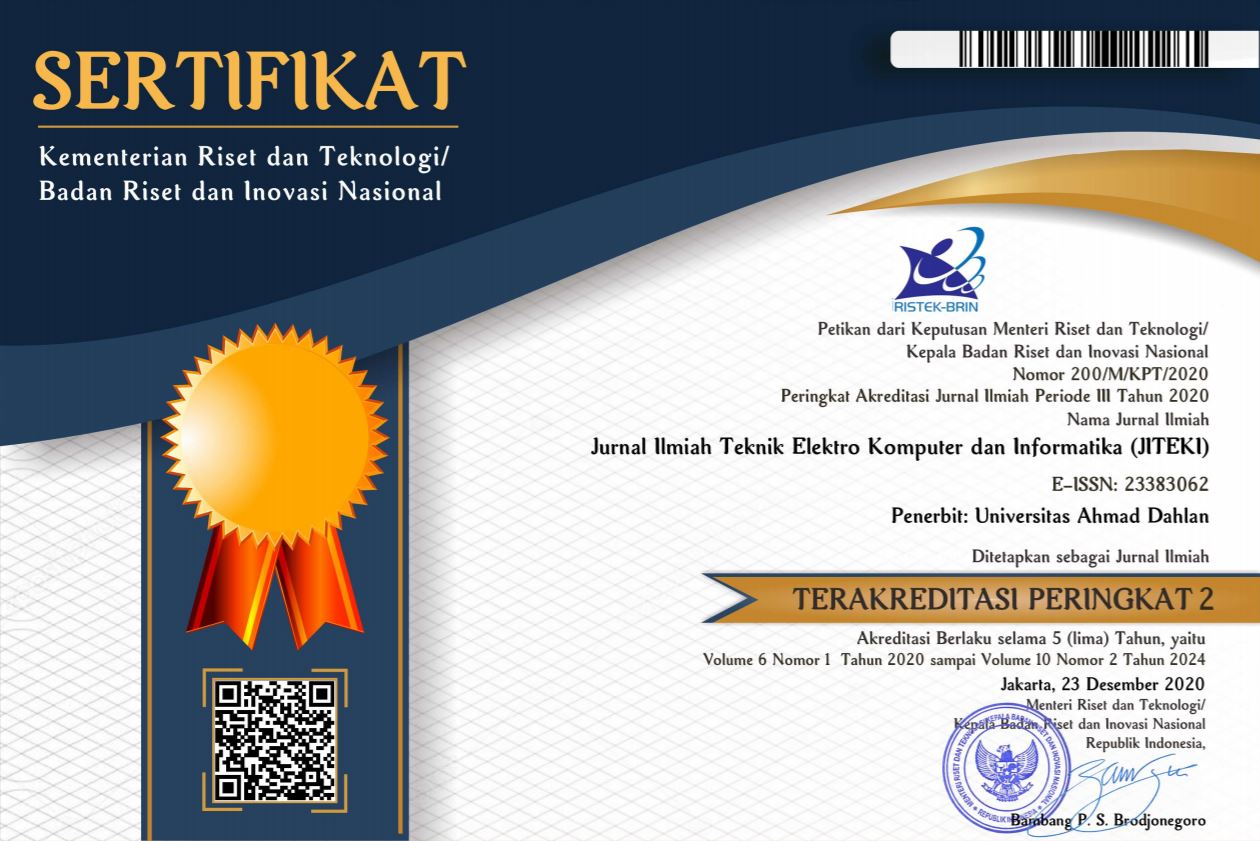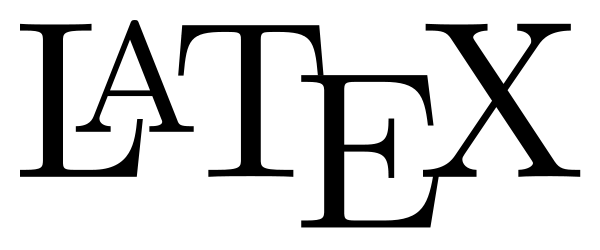Online Submissions
Already have a Username/Password for Jurnal Ilmiah Teknik Elektro Komputer dan Informatika?
Go to Login
Need a Username/Password?
Go to Registration
Registration and login are required to submit items online and to check the status of current submissions.
Author Guidelines
Papers are invited from anywhere in the world, and so authors are asked to ensure that sufficient context is provided for all readers to appreciate their contribution.
Carefully read the submission guidelines as follows:
A. General Requirements
The minimum standard requirements of Jurnal Ilmiah Teknik Elektro Komputer dan Informatika must be
- Written in English (started in 2019).
- The length of the submitted paper is at least 6 pages and no more than 16 pages. Editors will be evaluated if the papers are needing more pages than 16 pages.
- Use a tool such as Zotero, Mendeley, or EndNote for reference management and formatting (or use the manual references if difficult)
- Make sure that your paper is prepared using the JITEKI template (MSWord)
B. Structure of The Manuscript
The manuscript must be prepared and suggested present following the structure:
- Title. The title of the article should be fewest, without Acronym or abbreviation
- Abstract. The Abstract has 200-300 Words; with No citation; State in the abstract a primary objective, research design, research contribution, methodology, main outcomes, results, and conclusions.
- Section structure. Authors are suggested to present their articles in the section structure: Introduction, Method, Results and Discussion, and Conclusion
- References. Expect a minimum of 40 references primarily with a minimum of 80% to international journal papers from Science Direct or indexed by Scopus Database, and choose IEEE style. Please don't use unpredictable website sources.
One author should be designated as the corresponding author and provide the following information:
- E-mail address
- Full postal address
Learn about the elements that organize a typical journal article and how to compose your work to help communicate your ideas more clearly.
Title
The article’s title should be specific, concise, and descriptive to help readers decide if they should read the full article. Use keywords and short phrases to describe the article’s content in as few words as possible. Avoid terms such as “new” or “novel” since the reader already knows your research is new and worthy of publication.
Abstract
Your abstract should provide a brief summary of the research conducted. The conclusions reached and the potential implications of those conclusions.
A strong abstract will also:
- Consist of a single paragraph of up to 250 words, with correct grammar and unambiguous terminology
- Be self-contained, without abbreviations, footnotes, references, or mathematical equations
- Highlight what is novel in your work
- Include 3-5 keywords or phrases that describe the research to help readers find your article
Most authors write the abstract last and edit it multiple times before article publication to ensure it accurately captures the entire article.
We recommend not including mathematical symbols in your article title or abstract because they may not display properly.
Keywords
Using the right keywords in your article can make your article more easily and reliably discoverable—which leads to a broader readership for your article.
Introduction
The introduction section includes a review of the existing literature to position your research within the broader scientific field and show your work's novelty. The introduction should also describe the question you’re trying to answer with your research and why that question is important to the field.
Methods
The methods section is a straightforward description of what you did in your research and how you did it. A detailed method section will make your article reproducible by other researchers, which helps others trust and build upon your work.
Equations
Ensure your mathematical equations and formulas display correctly in your published article. The equation can be made using the insert equation feature in Ms. Word feature.
Results and Discussion
The results section describes the results you obtained in your research. Include figures and tables as appropriate to illustrate your results. Figures can show data trends or other visual information. Tables are best to use when the exact values are important.
In the discussion section, please describe your results and how they contribute to the research field.
Conclusions
The conclusion section can highlight potential broader implications of your work and areas that need further study. Be careful not to inflate your findings.
References
The reference section is important because all scientific and technical research builds upon previous work. References help give proper credit and attribution to the preceding body of work. References also support and validate your hypothesis. Be sure to only cite references that directly support your work. Inflating citations by adding unnecessary references is considered a breach of publishing ethics.
Acknowledgments
You can recognize and thank those who have helped you publish this article in the acknowledgments section. Here you can thank your funder, someone who supported you during the research project, or the anonymous reviewers who evaluated the article. The Acknowledgements section is optional but quite common.
Please note that any papers which fail to meet our requirements will be returned to the author for amendment. Only papers that are submitted in the correct style will be considered by the Editors.
Please see the Journal Article Template below.
Please see the tutorial for submission here
https://youtu.be/yaP0JPoK6mQ
Submission Preparation Checklist
As part of the submission process, authors are required to check off their submission's compliance with all of the following items, and submissions may be returned to authors that do not adhere to these guidelines.
- The submission has not been previously published, nor is it before another journal for consideration (or an explanation has been provided in Comments to the Editor).
- The minimal reference is 40 from journals that were published 5 years ago.
- The maximal plagiarism is 30%, with each source maximal 4%.
Is your manuscript adhere to the minimum standards?
- Written in English;
- The length of the submitted paper is at least 6 pages and no limit pages;
- Use a tool such as EndNote, Mendeley, or Zotero for reference management and formatting, and choose IEEE style.
- Introduction section: authors must provide the research contribution in the section.
Copyright Notice
Authors who publish with JITEKI agree to the following terms:
- Authors retain copyright and grant the journal the right of first publication with the work simultaneously licensed under a Creative Commons Attribution License (CC BY-SA 4.0) that allows others to share the work with an acknowledgment of the work's authorship and initial publication in this journal.
- Authors are able to enter into separate, additional contractual arrangements for the non-exclusive distribution of the journal's published version of the work (e.g., post it to an institutional repository or publish it in a book), with an acknowledgment of its initial publication in this journal.
- Authors are permitted and encouraged to post their work online (e.g., in institutional repositories or on their website) prior to and during the submission process, as it can lead to productive exchanges, as well as earlier and greater citation of published work.

This work is licensed under a Creative Commons Attribution 4.0 International License
Privacy Statement
The names and email addresses entered in this journal site will be used exclusively for the stated purposes of this journal and will not be made available for any other purpose or to any other party.
Author Fees
This journal charges the following author fees.
Article Publication: 2000000.00 (IDR)
Article publication only for the Indonesian Author. The author from outside Indonesia is free of charge.
The author will be asked to pay an Article Publication Fee to cover publication costs after the article is accepted.
This journal charges the article publication fee for supporting the cost of wide-open access dissemination of research results, managing the various costs associated with handling and editing of the submitted manuscripts, and the Journal management and publication in general, the authors or the author's institution is requested to pay a publication fee for each article accepted.
The publication processing covers DOI registration for each paper, Checking the article similarity by Turnitin and Plagiarism X checker, Grammarly Checking, and English Proofread.




